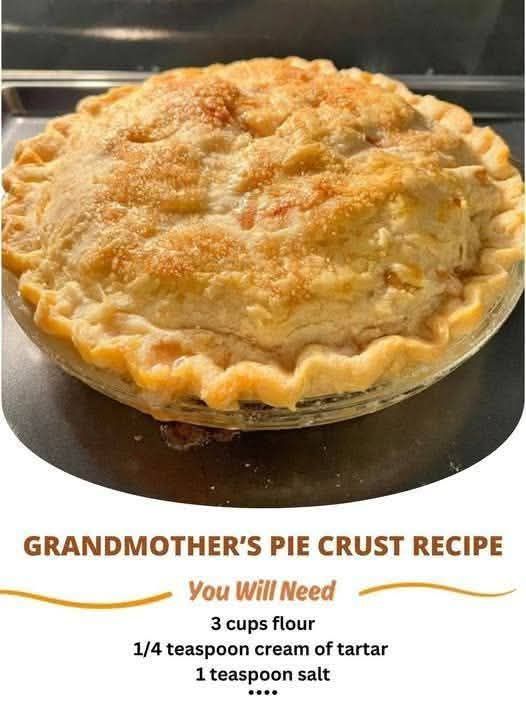Okay, gather ’round, buttercup! Let’s talk pie crust. Not just any pie crust, but my grandmother’s pie crust recipe. The kind that makes holidays feel like holidays, and even a Tuesday night slice feel special. This isn’t a fancy, complicated recipe. It’s the real deal, passed down through generations, and now, I’m sharing it with you.
The Magic of Grandma’s Pie Crust: A Time-Tested Recipe
Grandma’s pie crust recipe is more than just flour and butter; it’s a feeling. It’s the warmth of her kitchen, the scent of apples baking, and the sound of laughter echoing through the house. This recipe is simple, honest, and yields a perfectly flaky, melt-in-your-mouth crust every single time. And that, my friend, is pure magic.

The Key Ingredients (and Why They Matter!)
Grandma always said, “Use good ingredients, and treat them right.” Here’s the breakdown of what you’ll need and why each component is so important for achieving pie crust perfection:
Flour: The Foundation
All-purpose flour is the workhorse of this recipe. While some bakers swear by pastry flour, Grandma always used all-purpose, and her crust was always incredible. The key is to not overwork the gluten. King Arthur Baking Company has a great guide to different flours if you want to explore! Just remember to keep it simple at first.

Fat: Butter and Shortening – A Winning Combination
Grandma’s secret? A blend of butter and shortening. The butter adds flavor, while the shortening creates flakiness. Using all butter can result in a tougher crust, while all shortening lacks that beautiful buttery taste. This blend gives you the best of both worlds.
- Butter: Use cold, unsalted butter. Cut it into small cubes before you start.
- Shortening: Vegetable shortening works best. Also needs to be cold!

Water: The Binder
Ice water is crucial. It keeps the fat cold, which is essential for creating those lovely flaky layers. Add it gradually, just until the dough comes together.

Salt: The Enhancer
Don’t skip the salt! It balances the flavors and enhances the sweetness of the filling.

Grandma’s Step-by-Step Pie Crust Recipe
Ready to bake? Here’s the recipe, broken down into easy-to-follow steps.
- Combine Dry Ingredients: In a large bowl, whisk together 2 1/2 cups all-purpose flour and 1 teaspoon salt.
- Cut in the Fat: Add 1 cup (2 sticks) cold, unsalted butter (cut into cubes) and 1/2 cup cold vegetable shortening. Use a pastry blender or your fingertips to cut the fat into the flour until the mixture resembles coarse crumbs.
- Add Water Gradually: Gradually add 6-8 tablespoons of ice water, one tablespoon at a time, mixing gently after each addition. The dough should just come together without being sticky.
- Form Dough: Divide the dough in half. Flatten each half into a disc, wrap in plastic wrap, and refrigerate for at least 30 minutes (or up to 2 days).
- Roll Out Dough: On a lightly floured surface, roll out one disc of dough into a 12-inch circle.
- Transfer to Pie Plate: Carefully transfer the dough to a 9-inch pie plate. Trim and crimp the edges as desired.
- Fill and Bake: Fill with your favorite pie filling and bake according to the filling recipe instructions.

Tips and Tricks for Pie Crust Success
Here are a few more pearls of wisdom gleaned from years of watching Grandma bake:
- Keep Everything Cold: This is the golden rule of pie crust. Cold ingredients prevent the fat from melting too quickly, which is essential for flakiness.
- Don’t Overwork the Dough: Overworking develops the gluten, resulting in a tough crust. Mix gently and only until the dough comes together.
- Rest the Dough: Refrigerating the dough allows the gluten to relax, making it easier to roll out.
- Use a Pastry Blender: While you can use your fingers, a pastry blender makes cutting in the fat much easier and more consistent.
- Blind Bake: For pies with a wet filling (like custard or cream pies), blind bake the crust first to prevent a soggy bottom. Use pie weights or dried beans to keep the crust from puffing up.

Troubleshooting Common Pie Crust Problems
Even with the best recipe, sometimes things go awry. Here’s how to tackle common pie crust issues:
Tough Crust
Overworking the dough is the main culprit. Mix gently and don’t add too much water.
Crust Shrinking
This can happen if the dough wasn’t rested long enough or if it was stretched too much when transferring it to the pie plate. Let the dough relax in the fridge before rolling, and be gentle when placing it in the pie plate.
Soggy Bottom
Blind bake the crust or use a preheated baking sheet under the pie plate to help crisp the bottom crust.

Conclusion: Share the Pie (and the Love!)
Grandma’s pie crust recipe is a gift. It’s a reminder of simpler times, of shared meals, and of the love that goes into every homemade pie. I hope you’ll try this recipe and create your own memories with it. And most importantly, remember to share the pie with those you love! Happy baking!

